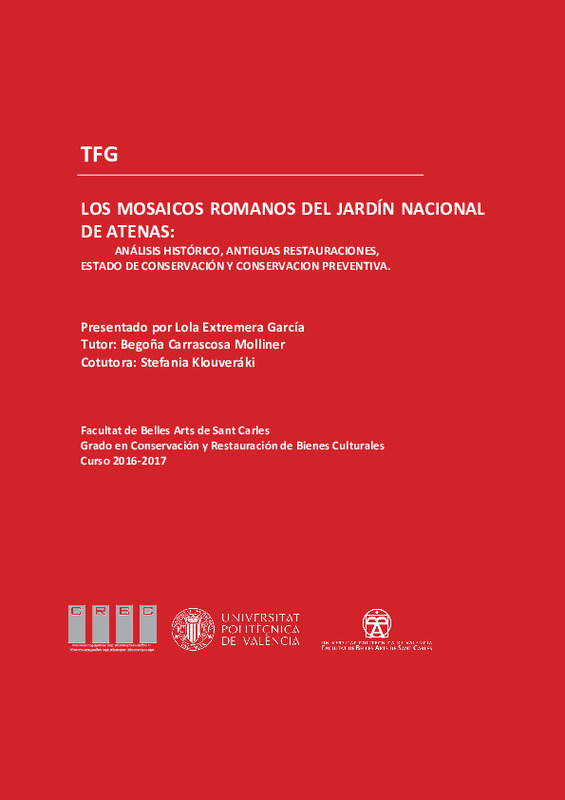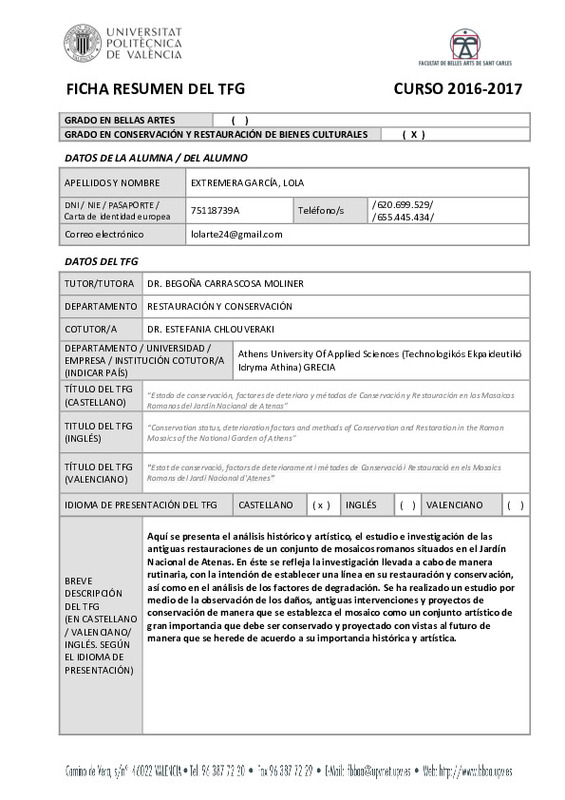JavaScript is disabled for your browser. Some features of this site may not work without it.
Buscar en RiuNet
Listar
Mi cuenta
Estadísticas
Ayuda RiuNet
Admin. UPV
LOS MOSAICOS ROMANOS DEL JARDÍN NACIONAL DE ATENAS: ANÁLISIS HISTÓRICO, ANTIGUAS RESTAURACIONES, ESTADO DE CONSERVACIÓN Y CONSERVACION PREVENTIVA
Mostrar el registro sencillo del ítem
Ficheros en el ítem
| dc.contributor.advisor | Carrascosa Moliner, María Begoña
|
es_ES |
| dc.contributor.author | Extremera García, Lola
|
es_ES |
| dc.date.accessioned | 2017-12-15T15:53:26Z | |
| dc.date.available | 2017-12-15T15:53:26Z | |
| dc.date.created | 2017-07-13 | |
| dc.date.issued | 2017-12-15 | es_ES |
| dc.identifier.uri | http://hdl.handle.net/10251/92933 | |
| dc.description.abstract | The Roman Mosaics set in the heart of the National Gardens of Athens, an extensive park of about 16 hectares that was built by Queen Amalia in 1840, was a genuine discovery when, by causality, they were unearthed. Its discovery was made by doing some works of cleaning the garden area. It remained reserved for study for a time until the TEI has taken responsibility for its study, consolidation and restoration, interventions that will culminate with the maintenance and use for tourism purposes with the control by the Greek State. This final degree work approachs: the physical characteristics of these Roman Mosaics, the deterioration caused by time and environmental factors, the key elements in their conservation, the mechanisms that will be carried out to avoid their degradation in time and the vicissitudes that they suffered through the times until the discovery, due to their location, the study of the surrounding areas realized by the TEI team, of which I am part as a restore student and researcher for this project, the guidelines determined by the team for their intervention, defining clearly its actual state, as well as an hypothetical study as spectator-mosaic loop, and get more visitors can be reached in a more dynamic and instructive way. In addition, I analyze the interventions of the most recent performance reports that have been used by the university team in their work. Besides, I value the tasks performed on the mosaics, following the more innovative principles of restoration of Roman Mosaics that are using the restoration teams in Athens. I anticipate with objective and scientific view the final result that is intended in this action so important for the Greek archaeological heritage. My conclusions assume the final result of the intervention, demonstrate my participation in the work of the group and put in value the future lines of action until the conclusion of the intervention. All this, in the light of an intense and precise bibliography of the reality of the Roman mosaic from the perspective of its history, restoration and conservation. | es_ES |
| dc.description.abstract | Los Mosaicos Romanos enclavados en el corazón de los Jardines Nacionales de Atenas, un extenso parque de unas 16 hectáreas que fue mandado construir por la reina Amalia en el año 1840, supusieron un genuino descubrimiento cuando, por causalidad, fueron desenterrados. Su descubrimiento se produjo realizando unos trabajos de adecentamiento de la zona ajardinada. Permaneció reservado para su estudio durante un tiempo hasta que el TEI se ha hecho responsable de su estudio, consolidación y restauración, intervenciones que culminarán con el mantenimiento y utilización para fines turísticos con el control por parte del Estado Griego. Este trabajo final de grado aborda: las características físicas de estos mosaicos romanos, el deterioro ocasionado por el tiempo y los factores medioambientales, elementos clave en su conservación, los mecanismos que se llevarán a cabo para evitar su degradación en el tiempo y las vicisitudes que éstos sufrieron a través de los tiempos hasta su hallazgo, dado su localización, el estudio de las zonas circundantes realizado por el equipo del TEI, del que formo parte como alumna restauradora e investigadora para este proyecto, las directrices determinadas por el equipo para su intervención, definiendo claramente su estado actual, así como un estudio hipotético a modo de lazo espectador-mosaico, de forma que se consiga alcanzar mayor número de visitantes, de una forma más dinámica e instructiva. Además, analizo las intervenciones de los informes de actuación más recientes de los que se ha servido el equipo de la universidad en su trabajo. Además, valoro las tareas hasta ahora ejecutadas sobre los mosaicos, siguiendo los principios de restauración de mosaicos romanos más innovadores que están utilizando los equipos restauradores en Atenas. Anticipo con mirada objetiva y científica el resultado final que se pretende en esta actuación tan importante para el patrimonio arqueológico griego. Mis conclusiones asumen el resultado final de la intervención, demuestran mi participación en el trabajo del grupo y ponen en valor las líneas de actuación futuras hasta la conclusión de la intervención. Todo ello, a la luz de una bibliografía intensa y precisa de la realidad del mosaico romano desde la óptica de su historia, restauración y conservación. | es_ES |
| dc.format.extent | 37 | es_ES |
| dc.language | Español | es_ES |
| dc.publisher | Universitat Politècnica de València | es_ES |
| dc.rights | Reserva de todos los derechos | es_ES |
| dc.subject | Roman Mosaics. Musivary Intervention. Restoration and Conservation. Greek Heritage. Diffusion | es_ES |
| dc.subject | Mosaicos Romanos. Intervención Musiva. Restauración y Conservación. Patrimonio griego. Difusión. | es_ES |
| dc.subject.classification | PINTURA | es_ES |
| dc.subject.other | Grado en Conservación y Restauración de Bienes Culturales-Grau en Conservació i Restauració de Béns Culturals | es_ES |
| dc.title | LOS MOSAICOS ROMANOS DEL JARDÍN NACIONAL DE ATENAS: ANÁLISIS HISTÓRICO, ANTIGUAS RESTAURACIONES, ESTADO DE CONSERVACIÓN Y CONSERVACION PREVENTIVA | es_ES |
| dc.type | Proyecto/Trabajo fin de carrera/grado | es_ES |
| dc.rights.accessRights | Abierto | es_ES |
| dc.contributor.affiliation | Universitat Politècnica de València. Departamento de Conservación y Restauración de Bienes Culturales - Departament de Conservació i Restauració de Béns Culturals | es_ES |
| dc.contributor.affiliation | Universitat Politècnica de València. Facultad de Bellas Artes - Facultat de Belles Arts | es_ES |
| dc.contributor.affiliation | Universitat Politècnica de València. Instituto Universitario de Restauración del Patrimonio - Institut Universitari de Restauració del Patrimoni | es_ES |
| dc.description.bibliographicCitation | Extremera García, L. (2017). LOS MOSAICOS ROMANOS DEL JARDÍN NACIONAL DE ATENAS: ANÁLISIS HISTÓRICO, ANTIGUAS RESTAURACIONES, ESTADO DE CONSERVACIÓN Y CONSERVACION PREVENTIVA. http://hdl.handle.net/10251/92933 | es_ES |
| dc.description.accrualMethod | TFGM | es_ES |
| dc.relation.pasarela | TFGM\59652 | es_ES |
Este ítem aparece en la(s) siguiente(s) colección(ones)
-
BBAA - Trabajos académicos [4517]
Facultad de Bellas Artes







